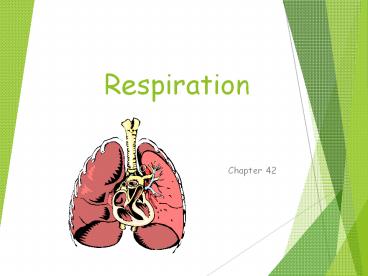Respiration - PowerPoint PPT Presentation
Title:
Respiration
Description:
Respiration Chapter 42 Transport of gas Blood that leaves lungs 97% saturated Circulates oxygen diffuses into tissues 75% saturated Allows for reserves of oxygen ... – PowerPoint PPT presentation
Number of Views:153
Avg rating:3.0/5.0
Title: Respiration
1
Respiration
- Chapter 42
2
Respiration
- Gas exchange
- Movement of gas across membrane
- Diffusion (passive)
- To improve gas absorption
- Increase surface area for diffusion
- Decrease distance diffused gas travels
- Respiratory organs
3
Fish
4
Amphibians
- Lungs
- Cutaneous respiration
5
Amphibians
6
Birds
- Parabronchi (lungs)
- Air sacs
7
Fig. 42-26
Air
Air
Anterior air sacs
Trachea
Posterior air sacs
Lungs
Lungs
Air tubes (parabronchi) in lung
1 mm
EXHALATION Air sacs empty lungs fill
INHALATION Air sacs fill
8
Anatomy
- Mouth (nose)
- Pharynx (back of throat)
- Larynx (voice box)
- Trachea
9
Anatomy
10
Anatomy
11
Anatomy
- Bronchi (Bronchus)
- Bronchioles
- Alveoli
- Air sacs
- Gas exchange
- One cell layer thick
- Lung tissue consists of millions
12
Anatomy
13
Anatomy
14
Anatomy
- Lungs
- 3 right lobes
- RUL, RML, RLL
- 2 left lobes
- LUL, LLL
15
Anatomy
16
Anatomy
17
(No Transcript)
18
Anatomy
- Lung covered by a double folded membrane
- Visceral pleural membrane
- Covers the lung
- Parietal pleural membrane
- Lines inner wall of thoracic cavity
19
Anatomy
- Pleural cavity
- Space between two membranes
- Filled with fluid
- Helps with movement of lungs
20
Breathing
- Diaphragm
- Muscle
- Separates thoracic cavity from abdominal cavity
- Intercostal muscles
- Muscles between the ribs
21
Inhalation (inspiration)
- Diaphragm contracts flattens
- Intercostal muscles contract
- Raises the ribs
- Increases volume (decreases pressure)
- Air flows into the lungs
22
Exhalation (expiration)
- Diaphragm relaxes elevates
- Intercostal muscles relax
- Ribs lower
- Decreased volume
- Forces air out
23
Breathing
24
Breathing measurements
- Tidal volume
- Amount of air moved into out of lungs at rest
- Vital capacity
- Maximum amount of air that can be expired after
forceful exhalation
25
Breathing measurements
26
Control of breathing
- Normal breathing
- Medulla oblongata
- Respiratory control center
- Neurons send impulse for muscles
(diaphragm/intercostal) to contract - Inspiration (inhalation)
- Stop sending impulse
- Expiration (exhalation)
27
Control of breathing
- Blood O2 CO2 in normal range
- Neurons respond to a change in O2 CO2
- More response to CO2
- Increase CO2
- Increases carbonic acid (H2CO3)
- CO2 H2O ?H2CO3 ? H HCO3
- Lowers pH
28
Control of breathing
- Stimulates peripheral chemoreceptors
- Aorta carotids
- Send impulses to respiratory control center
(medulla oblongata) - Stimulates increased breathing
29
Control of breathing
- Central chemoreceptors
- Located in brain
- Respond to increased amount of CO2
- Peripheral receptors immediate response
- Central receptors maintained response until pH is
back to normal
30
Transport of gas
- Hemoglobin
- Contains four heme groups
- Center of each heme group is an iron
- Oxygen binds the iron (4 O2 molecules)
- Oxygen in blood is mostly bound to Hgb
- Little is dissolved plasma
31
Transport of gas
32
Transport of gas
- Oxyhemoglobin
- Hemoglobin full of oxygen
- Lungs
- Deoxyhemoglobin
- Hemoglobin releases some oxygen
- Capillaries
33
(No Transcript)
34
Transport of gas
- Blood that leaves lungs 97 saturated
- Circulates oxygen diffuses into tissues
- 75 saturated
- Allows for reserves of oxygen
- Exercise
- Cardiac arrest
35
Transport of gas
- Decreased pH
- Lower affinity of oxygen for hemoglobin
- Releases oxygen
- Increased temperature
- Lower affinity
- Exercise
- Increased CO2, decreased pH, increased
temperature - Increased release of O2 to muscles
36
Transport of gas
- CO2
- In tissues
- Small amount bound to protein part of Hgb
- Remaining CO2 in RBC
- Forms carbonic acid H2CO3
- Carbonic anhydrase
37
Transport of gas
- Carbonic acid separates
- Bicarbonate (HCO3-1) H1
- Buffer
- Blood at alveoli
- Carbonic anhydrase reverses
- Forms water CO2
- CO2 diffuses into lungs
38
Abnormalities
- Emphysema
- Lung disease that destroys alveoli sacs
- Decreases vital capacity
- Traps air
- Hypoventilation
- Decreased air movement increased CO2
- Hyperventilation
- Increased air movement decreased CO2
39
Emphysema
40
(No Transcript)
41
(No Transcript)
42
(No Transcript)































